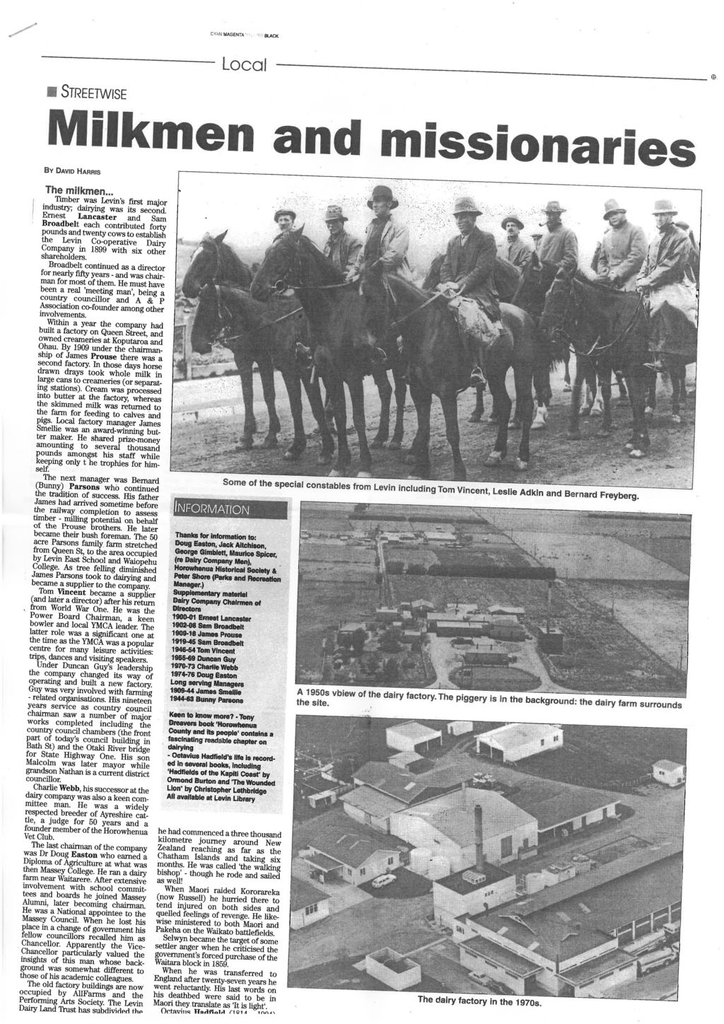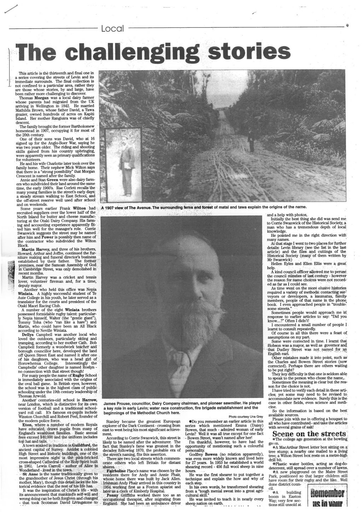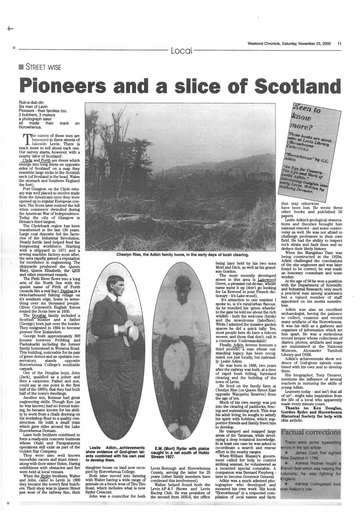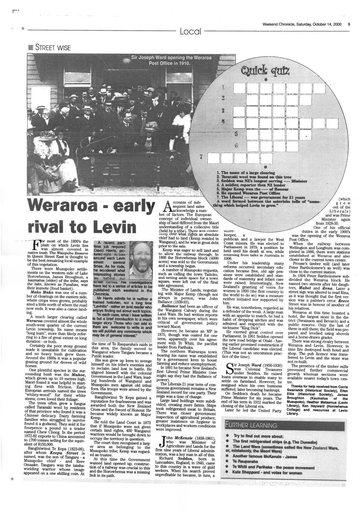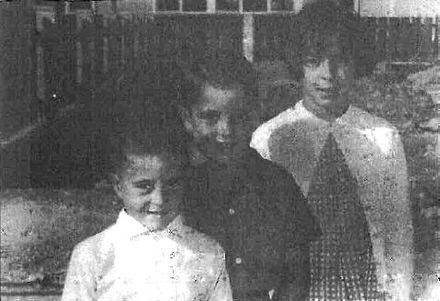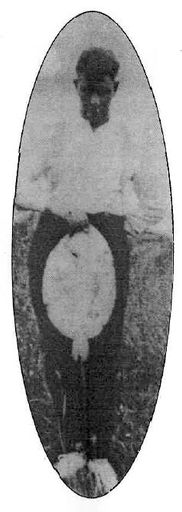Milkmen and missionaries
- Description
The milkmen...
Timber was Levin's first major industry; dairying was its second. Ernest Lancaster and Sam Broadbelt each contributed forty pounds and twenty cows to establish the Levin Co-operative Dairy Company in 1899 with six other shareholders. Broadbelt continued as a director for nearly fifty years - and was chairman for most of them. He must have been a real 'meeting man', being a country councillor and A & P Association co-founder among other involvements.
Within a year the company had built a factory on Queen Street, and owned creameries at Koputaroa and Ohau. By 1909 under the chairman-ship of James Prouse there was a second factory . In those days horse drawn drays took whole milk in large cans to creameries (or separating stations). Cream was processed into butter at the factory whereas the skimmed milk was returned to the farm for feeding to calves and pigs. Local factory manager James Smellie was an award-winning butter maker. He shared prize-money amounting to several thousand pounds amongst his staff while keeping only the trophies for himself. The next manager was Bernard (Bunny) Parsons who continued the tradition of success. His father James had arrived sometime before the railway completion to assess timber - milling potential on behalf of the Prouse brothers. He later became their bush foreman. The 50 acre Parsons family farm stretched from Queen St, to the area occupied by Levin East School and Waiopehu College. As tree felling diminished James Parsons took to dairying and became a supplier to the company. Tom Vincent became a supplier (and later a director) after his return from World War One. He was the Power Board Chairman, a keen bowler and local YMCA leader. The latter role was a significant one at the time as the YMCA was a popular centre for many leisure activities: trips, dances and visiting speakers. Under Duncan Guy's leadership the company changed its way of operating and built a new factory. Guy was very involved with fanning - related organisations. His nineteen years service as country council chairman saw a number of major works completed including the country council chambers (the front part of today's council building in Bath St) and the Otaki River bridge for State Highway One. His son Malcolm was later mayor while grandson Nathan is a current district councillor. Charlie Webb, his successor at the dairy company was also a keen committee man. He was a widely respected breeder of Ayreshire cattle, a judge for 50 years and a founder member of the Horowhenua Vet Club. The last chairman of the company was Dr Doug Easton who earned a Diploma of Agriculture at what was then Massey College. He ran a dairy farm near Waitarere. After extensive involvement with school committees and boards he joined Massey Alumni, later becoming chairman. He was a National appointee to the Massey Council. When he lost his place in a change of government his fellow councillors recalled him as Chancellor. Apparently the Vice-Chancellor particularly valued the insights of this man whose back-ground was somewhat different to those of his academic colleagues. The old factory buildings are now occupied by AllFarms and the Performing Arts Society. The Levin Dairy Land Trust has subdivided the involvement with school committees and boards he joined Massey Alumni, later becoming chairman. He was a National appointee to the Massey Council. When he lost his place in a. change of government his fellow councillors recalled him as Chancellor. Apparently the Vice Chancellor particularly valued the insights of this man whose back-ground was somewhat different to those of his academic colleagues. The old factory buildings are now occupied by AllFarms and the Performing Arts Society The Levin Dairy Land Trust has subdivided the adjoining land for the polytech and residential sections - there being less than ten left for sale. , One exciting prospect for the area is the public reserve which will have access from Vincent Drive, Martin Harvey St, and Easton Way. This 1.6 hectare site - about the equivalent of three rugby fields will be a welcome oasis of green. The first stage of development will begin in early 2001 after which we will be asked for our ideas. Be ready! Apart from those mentioned already, other nearby streets honour men who were directors of the dairy company at the time of the factory closure - Charlie Wright, Alan Lynch, Jack Aitchison and George Gimblett.
...and missionaries Samuel Marsden (1765-1838) led New Zealand's first Christian service in the Bay if Islands on Christmas Day 1814. He was based in New South Wales, where he was an Anglican chaplain, magistrate, farmer and successful businessman. Marsden was the driving force behind the first missionary efforts here through his seven visits over a 23 year period. He saw such value in passing European know-how on to Maori that his first missionary team comprised of a teacher, a twine-spinner and a carpenter. Just a few years after Marsden's last Visit, Charles Selwyn (1809-1878) sailed from England - a man of great mental and physical energy. After shipboard study he preached in Maori on his first Sunday here. Within two weeks he had commenced a three thousand kilometre journey around New Zealand reaching as far as the Chatham Islands and taking six months. He was called the walking bishop - though he rode and sailed as well! When Maori raided Kororareka (now Russell) he hurried there to tend injured on both sides and quelled feelings of revenge. He like-wise ministered to both Maori and Pakeha on the Waikato battlefields. Selwyn became the target of some settler anger when he criticised the government's forced purchase of the Waitara block in 1859. When he was transferred to England after twenty-seven years he went reluctantly. His last words on his deathbed were said to be in Maori they translate as 'It is light'.
When Maori -raided Kororareka (now Russell) he hurried there to tend injured on both sides and quelled feelings of revenge. He likewise ministered to both Maori and Pakeha on the Waikato battlefields.
Selwyn became the target of some settler anger when he criticised the government's forced purchase of the Waitara block in 1859. When he was transferred to England after twenty-seven years he went reluctantly His last words on his deathbed were said to be in Maori they translate as 'It is light'.
Octavius Hadfield (1814 - 1904) was not the robust physical specimen that his fellow bishop Selwyn was yet this man of delicate appearanc e soon impressed New Zealanders as being as brave as a lion and in spite of Chrome ill health he lived to the age of ninety. His inspiration for bringing Christ’s message to the outermost islands was reading his master's command like `Go and make disciples of all nation':
Soon after arrival he volunteered to serve on the dangerous Kapiti coast reasoning that he could only the once. In Otaki he unknowingly broke tapu in the garden of the chief, leading an elderly tohunga to put a curse on him. Next morning Hadfield was still alive, but the tohtunga was dead; the newcomers mana skyrocketed, though he was quick to attribute the old man's death to natural. causes. He established Hadfield Town which in time became Otaki; His work saw the remarkable transformation of three great tribes, - Ngatitoa, Raukawa and Ngatiawa (involvedin cannibalism, infanticide and other destructive practices) to professing Christians who lived differently. Like Selwyn he spoke out against government handling of Maori land and he was a peacemaker in the wars of the Mid 1800s. One highly visible fruit of his life was Otaki's Rangiatea Church - sadly burnt to the ground a few years ago. Perhaps as the replacement structure arises, so too will local appreciation of a true hero who accomplished much good in Horowhenua.
 Photo: Some of the special constables fro m Levin including Torn Vincent, Leslie Adkin a nd Bernard Freyberg - From right [? left]:
Photo: Some of the special constables fro m Levin including Torn Vincent, Leslie Adkin a nd Bernard Freyberg - From right [? left]: - , Tom Vincent, Hector McDonald, -, Bert Denton, Jack Bartholomew, Bernard Freyberg, Leslie Adkin. Zac photo, from the G. Leslie Adkin collection.INFORMATION
Thanks for information to Doug Easton, Jack Aitchison, George Gimblett, Maurice Spicer, (re Dairy Company Men), Horowhenua Historical Society & Peter Shore (Parks and Recreation Manager.)Supplementary material
Dairy Company Chairmen of Directors:
1909-01 Ernest Lancaster
1902-8 Sam Broadbelt
1909-18 James Prouse
1919-45 Sam Broadbelt
1946-54 Tem Vincent
1955-69 Duncan Guy
1970-73 Charlie Webb
1974-76 Doug Easton
Long serving Managers:
1909-44 James Smellie
1944-63 Bunny ParsonsKeen to know more? Tony Cleavers book Horowhenua County and its people contains a fascinating readable chapter on dairying
– Octavius Hadfield's life is recorded in several hooks, including 'Hadfields of the Kapiti Coast' by Ormond Burton and 'The Wounded Lion' by Christopher Lethbridge.
All available at Levin Library.Photo: A 1950s view of the dairy factory. The piggery is in the background: the dairy farm surrounds the site.
P
 hoto at left: The dairy factory in the 1970s.
hoto at left: The dairy factory in the 1970s. Photo:Charlie Webb, left, and Doug Easton.
Photo:Charlie Webb, left, and Doug Easton.
Identification
- Date
- circa 2000

